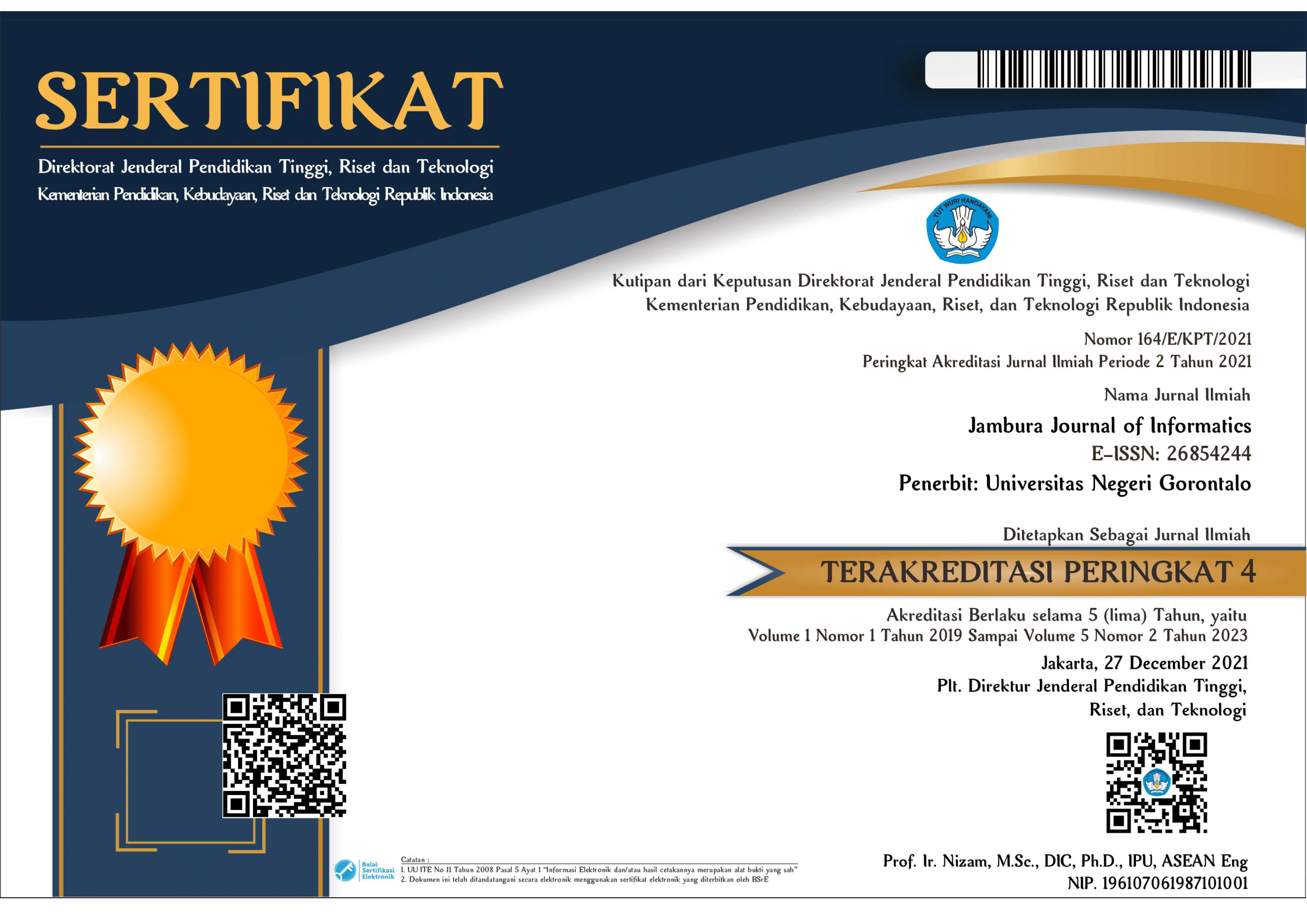CMI Computing: A Cloud, MANET, and Internet of Things Integration for Future Internet
Abstract
Keywords
Full Text:
PDF (English)References
Alam, T. (2017). Fuzzy control based mobility framework for evaluating mobility models in MANET of smart devices. ARPN Journal of Engineering and Applied Sciences. 12(15), 4526-4538.
Alam, T. (2018). A reliable framework for communication in internet of smart devices using IEEE 802.15.4. ARPN Journal of Engineering and Applied Sciences. 13(10), 3378-3387.
Alam, T. (2019). Middleware implementation in cloud-MANET mobility model for internet of smart devices. International Journal of Computer Science and Network Security, 17(5), 86-94.
Alam, T. (2019). Tactile internet and its contribution in the development of smart cities. arXiv preprint arXiv:1906.08554.
Alam, T. (2020). Cloud computing and its role in the information technology. IAIC Transactions on Sustainable Digital Innovation (ITSDI). 1, 108-115. DOI: https://doi.org/10.34306/itsdi.v1i2.103
Alam, T., & Sharma, B. K. (2010). A new optimistic mobility model for mobile ad hoc Networks. International Journal of Computer Applications. 8(3), 1-4. DOI: https://doi.org/10.5120/1196-1687
Alam, T., & Aljohani, M. (2015). An approach to secure communication in mobile ad-hoc networks of Android devices. In 2015 International Conference on Intelligent Informatics and Biomedical Sciences (ICIIBMS), 371-375. DOI: https://doi.org/10.1109/iciibms.2015.7439466
Alam, T., & Aljohani, M. (2015). Design and implementation of an ad hoc network among android smart devices. In Green Computing and Internet of Things (ICGCIoT), 2015 International Conference on, 1322-1327. DOI: https://doi.org/10.1109/ICGCIoT.2015.7380671
Alam, T., & Aljohani, M. (2016). Design a new middleware for communication in ad hoc network of android smart devices. In Proceedings of the Second International Conference on Information and Communication Technology for Competitive Strategies, p. 38. DOI: https://doi.org/10.1145/2905055.2905244
Alam, T., & Aljohani, M. (2020). Decision support system for real-time people counting in a crowded environment. International Journal of Electronics and Information Engineering. 12(1).
Alam, T., & Benaida, M. (2018). CICS: cloud–internet communication security framework for the internet of smart devices. International Journal of Interactive Mobile Technologies (iJIM). 12(6):74-84. DOI: https://doi.org/10.3991/ijim.v12i6.6776
Alam, T., & Benaida, M. (2018). The role of cloud-MANET framework in the Internet of Things (IoT). International Journal of Online Engineering (iJOE). 14(12), 97-111. DOI: https://doi.org/10.3991/ijoe.v14i12.8338
Alam, T., & Rababah, B. (2019). Convergence of MANET in communication among smart devices in IoT. International Journal of Wireless and Microwave Technologies (IJWMT). 9(2), 1-10. DOI: 10.5815/ijwmt.2019.02.01
Alam, T., Gupta, S., Tiwari, R., & Srivastava, A. P. (2010). Scanning the node using modified column mobility model. Computer Vision and Information Technology: Advances and Applications 455. I.K. International Publication.
Alam, T., Salem, A.A., Alsharif, A.O. & Alhejaili, A. M. (2020). Smart home automation towards the development of smart cities. APTIKOM Journal on Computer Science and Information Technologies. 5(1).
Deep, G., Mohana, R., Nayyar, A., Sanjeevikumar, P., & Hossain, E. (2019). Authentication protocol for cloud databases using blockchain mechanism. Sensors, 19(20), 1-13.
Estrin, D., Culler, D., Pister, K., & Sukhatme, G. (2002). Connecting the physical world with pervasive networks. IEEE Pervasive Computing, 1(1), 59-69.
Foster, I. (2000). Internet computing and the emerging grid. Nature. DOI: https://doi.org/10.1038/nature28024
Hoffmann, M., & Staufer, M. (2011). Network virtualization for future mobile networks: general architecture and applications. In 2011 IEEE International Conference on Communications Workshops (ICC), 1-5.
Jiang, L., Xu, L, D., Cai, H., Jiang, Z., Bu, F., & Xu, B. (2014). An IoT-oriented data storage framework in cloud computing platform. IEEE Transactions on Industrial Informatics, 10(2), 1443-1451.
Kortuem, G., Kawsar, F., Sundramoorthy, V., & Fitton, D. (2010). Smart objects as building blocks for the internet of things. IEEE Internet Computing. 14 (1), 44-51.
Mahapatra, B., Patnaik, S., & Nayyar, A. (2019). Effect of multiple-agent deployment in MANET. Recent Patents on Computer Science, 12(3), 180-190.
Nayyar, A. (2019). Handbook of cloud computing: basic to advance research on the concepts and design of cloud computing. BPB Publications.
Palattella, M. R,, Dohler, M., Grieco, A., Rizzo, G., Torsner, J., Engel, T., & Ladid, L. (2016). Internet of things in the 5G era: Enablers, architecture, and business models. IEEE Journal on Selected Areas in Communications. 34 (3), 510-527.
Rababah, B., Alam, T., & Eskicioglu, R. (2020). Next generation internet of things architecture towards distributed intelligence: reviews, applications, and research challenges. Journal of Telecommunication, Electronic and Computer Engineering, 12(2), 2020.
Rahmati, A., & Zhong, L. (2010). Context-based network estimation for energy-efficient ubiquitous wireless connectivity. IEEE Transactions on Mobile Computing, 10(1), 54-66.
Rathee, D., Ahuja, K., & Nayyar, A. (2019). Sustainable future IoT services with touch-enabled handheld devices. Security and Privacy of Electronic Healthcare Records: Concepts, Paradigms and Solutions, 131.
Singh, P., Gupta, P., Jyoti, K., & Nayyar, A. (2019). Research on auto-scaling of web applications in cloud: survey, trends and future directions. Scalable Computing: Practice and Experience, 20(2), 399-432.
Singh, S. P., Nayyar, A., Kumar, R., & Sharma, A. (2019). Fog computing: from architecture to edge computing and big data processing. The Journal of Supercomputing, 75(4), 2070-2105.
Statista. (2020). Internet of things-number of connected devices worldwide 2015-2025. https://www.statista.com/statistics/471264/iot-number-of-connected-devices-worldwide/
Welbourne, E., Battle, L., Cole, G., Gould, K., Rector, K., Raymer, S., Balazinska, M., & and Borriello, G. (2009). Building the internet of things using RFID: the RFID ecosystem experience. IEEE Internet Computing. 13(3), 48-55.
Yuste, A. J., Trivino, A., Casilari, E., and Trujillo, F. D. (2011). Adaptive gateway discovery for mobile ad hoc networks based on the characterization of the link lifetime. IET communications, 5(15), 2241– 2249.
Zhang, Q., & Agrawal, D. P. (2003). Dynamic probabilistic broadcasting in mobile ad hoc networks. 2003 IEEE 58th Vehicular Technology Conference. VTC 2003-Fall. 2003 IEEE.
DOI: https://doi.org/10.37905/jji.v2i1.4539
Refbacks
- There are currently no refbacks.
JJI has been indexed by:

| 
| 
| 
|

| 
| 
| 
|

|
| Editorial Office |
Engineering Faculty Building, 1st Floor Jl. Prof. Dr. Ing. B. J. Habibie, Bone Bolango, Gorontalo, 96119, Indonesia.Whatsapp: +6281314270499Email: jji.ft@ung.ac.id |
 |












